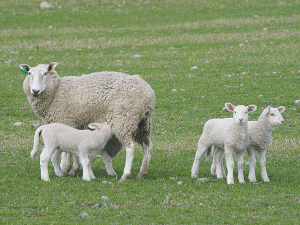Move over ham, here comes lamb
It’s official, lamb will take centre stage on Kiwi Christmas tables this year.
 Data shows domestic lamb prices across the season averaged just under $8.90/kg, the highest on record.
Data shows domestic lamb prices across the season averaged just under $8.90/kg, the highest on record.
Domestic lamb prices finished off the season, at September 30, in positive fashion and nudging a record high, according to the BNZ’s latest ‘Rural Wrap’ report.
Senior economist Doug Steele says data shows prices across the season averaged just under $8.90/kg, the highest on record and nearly 20% higher than the previous season.
However, he concedes this probably looks better than it really is with rising costs taking some of the gloss off.
However, inflationadjusted prices still rival the previous best season (2010/11).
Steele also warns that one strong season is no guarantee of another.
“Farmers will know more than anyone that lamb prices do not typically move in a straight line through time.”
BNZ has a cautious but mainly positive outlook for the coming season.
“This caution reflects a deteriorating global economic outlook with growth forecasts being progressively reduced,” Steele explains. “This includes materially weaker growth forecasts in key lamb markets like China.”
The bank points out that NZ’s rolling annual sheepmeat exports to China have been holding at around $1.7b over recent months, still down from around $2b a year ago.
“China’s share of NZ’s sheepmeat exports in the 12 months to August 2022 was about 37%, down from over 50% a year ago.”
The report says NZ sheepmeat exports to the UK and EU have been stronger over the past year, bringing some lift in those markets’ share of NZ exports.
“However, there are questions around how long this can last as the UK and EU suffer from the drag of nearby war and associated energy crisis biting,” Steele points out.
The report also adds that lower income growth in key lamb consuming markets is expected to be a drag on prices ahead.
“Cost of living pressures in the likes of the UK and EU are hurting consumers’ purchasing power and is likely to see some people ‘trading down’ the quality curve when it comes to purchasing decisions at the checkout.”
Meanwhile, the BNZ says the anticipated increase in Australian product, following an “impressive flock rebuilding phase”, seems to be underway. “Extension of this, which is expected, will be another factor to put downward pressure to prices.”
Steel adds that there are already seen signs of price softening in some offshore markets.
“The price of a leg of lamb in the UK has fallen nearly 17% over the past six months, while flap prices are back around 13% over the same period,” he says.
“Risks seem tilted to further weakness ahead at least in the near term.”
However, the report adds that it is not “all one-way traffic south”.
“For example, French rack prices have been holding high in the US. Lamb into the US has other bright spots too with the US becoming NZ’s largest market for chilled lamb for the first time ever,” Steele explains. “In part due to shipping risks elsewhere but also as a function of solid demand for NZ’s premium product aided by active promotion.”
The report highlights how the weakness in the NZ dollar, especially against the US dollar, is providing a significant cushion to lamb prices.
“The NZ dollar has recently dipped by a bit more than we anticipated, including against the GBP and EUR. If this were to persist, or extend, it would help offset the anticipated weakening in offshore prices such that domestic lamb prices may not fall as much as we currently expect.”
The report concludes that lower NZ lamb supply will play its part as well.
“Beef+Lamb NZ’s early estimates suggest this season’s lamb crop may be around 0.8% lower than last season,” it says.
“This reflects a decrease in breeding ewe numbers and unhelpful weather conditions. Final lamb tallies won’t be in for a month or two yet. But to the extent that NZ lamb supply is restricted, it will offer at least some support to price.”
According to the latest Federated Farmers banking survey, farmers are more satisfied with their bank and less under pressure, however, the sector is well short of confidence levels seen last decade.
Farmer confidence has taken a slight dip according to the final Rabobank rural confidence survey for the year.
Former Agriculture Minister and Otaki farmer Nathan Guy has been appointed New Zealand’s Special Agricultural Trade Envoy (SATE).
Alliance Group has commissioned a new heat pump system at its Mataura processing plant in Southland.
Fonterra has slashed another 50c off its milk price forecast as global milk flows shows no sign of easing.
Meat processors are hopeful that the additional 15% tariff on lamb exports to the US will also come off.

OPINION: The release of the Natural Environment Bill and Planning Bill to replace the Resource Management Act is a red-letter day…
OPINION: Federated Farmers has launched a new campaign, swapping ‘The Twelve Days of Christmas’ for ‘The Twelve Pests of Christmas’ to…